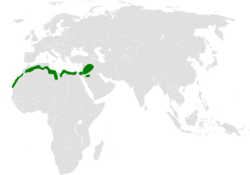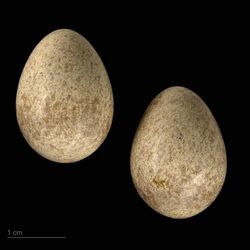Biology:Temminck's lark
| Temminck's lark | |
|---|---|

| |
| Scientific classification | |
| Domain: | Eukaryota |
| Kingdom: | Animalia |
| Phylum: | Chordata |
| Class: | Aves |
| Order: | Passeriformes |
| Family: | Alaudidae |
| Genus: | Eremophila |
| Species: | E. bilopha
|
| Binomial name | |
| Eremophila bilopha (Temminck, 1823)
| |

| |
| Synonyms | |
| |
Temminck's lark (Eremophila bilopha) or Temminck's horned lark, is a bird species of the family Alaudidae. It breeds across much of north Africa, through northern Saudi Arabia to western Iraq. It is mainly resident, but some populations of this passerine bird are partially migratory, moving further south in winter. This bird's common name commemorates the Dutch naturalist Coenraad Jacob Temminck.[2] The population is declining in Israel and may also be declining elsewhere, probably as a result of habitat loss. Nevertheless, this is a common bird in many parts of its wide range and the International Union for Conservation of Nature has rated its conservation status as being of "least concern".[1]
Taxonomy and systematics
Temminck's lark was originally placed in the genus Alauda before being re-classified to Eremophila.
Description
Unlike most other larks, Temminck's lark is a distinctive looking species on the ground, similar to the other, larger, member of its genus, the horned lark. The 14 to 15 cm (5.5 to 5.9 in) adult is mainly reddish brown-grey above and pale below, and it has a striking black and white face pattern and a distinctive black patch on its breast. The summer male has black "horns", which give this species its alternative name. The juvenile of this species is reddish above and pale below, quite unlike the juvenile horned lark. The adult Temminck's lark differs from the horned lark in its reddish, rather than brown-grey plumage, and the lack of yellow in the face pattern. It has a similar but less harsh metallic call.[3]
Distribution and habitat
Temminck's lark is native to North Africa and the Middle East. Its range includes Algeria, Egypt, Iraq, Israel, Jordan, Kuwait, Libya, Mauritania, Morocco, Saudi Arabia, Syria, Tunisia and Western Sahara.[1]
This lark is a bird of open stony semi-desert. Its nest is on the ground, with two to four eggs being laid. Its food is seeds supplemented with insects in the breeding season.[4]
References
- ↑ 1.0 1.1 1.2 BirdLife International (2016). "Eremophila bilopha". IUCN Red List of Threatened Species 2016: e.T22717438A94531890. doi:10.2305/IUCN.UK.2016-3.RLTS.T22717438A94531890.en. https://www.iucnredlist.org/species/22717438/94531890. Retrieved 12 November 2021.
- ↑ Beolens, Bo; Watkins, Michael (2003). Whose Bird? Men and Women Commemorated in the Common Names of Birds. London: Christopher Helm. pp. 335–336.
- ↑ Mark Beaman; Steve Madge (1998). The Handbook of Bird Identification: For Europe and the Western Palearctic. Christopher Helm. p. 568. ISBN 978-0-7136-3960-5. https://books.google.com/books?id=p968cQkfSroC&pg=PA568.
- ↑ "Temminck's Lark (Eremophila bilopha)". Handbook of the Birds of the World Alive. Lynx Edicions. http://www.hbw.com/node/57665.
Wikidata ☰ Q1193299 entry
 |



